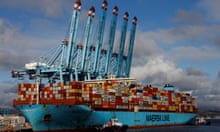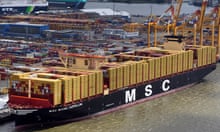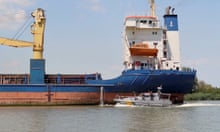Commercial ships are facing long queues and delays to travel through the Panama Canal as a lengthy drought in the Central American country has led to a cut in the number of vessels able to pass through one of the world’s most important trading routes.
In a fresh demonstration of the impact of the climate crisis on global business and trade, the Panama Canal Authority (ACP), which manages the waterway, introduced restrictions on the number of transiting vessels as a result of the drought.
An extended dry season has reduced the availability of water, required to allow vessels to pass through the canal’s locks, which has triggered a logjam of ships awaiting their turn.
The canal is favoured by many shippers as it usually reduces cost and transit times, especially for large retailers and energy companies that trade between China and the rest of Asia, and the US.
The ACP has said it faces “unprecedented challenges”, adding that the severity of the drought had “no historical precedence”, even compared with the last drought in 2019-20.
In late July, the state-owned ACP limited the number of vessels passing through the waterway each day to an average of 32, down from the usual 36. It also restricted the permitted maximum depth of ships.
The restrictions led to a bottleneck of ships waiting for their turn to cross and sent companies scrambling to find alternative routes.
Live maritime tracking websites showed about 140 vessels near the canal on Monday, a considerable increase from the level of about 90 ships usually seen in the area during the rainy season, which lasts from May to December.
This was slightly lower than the 160 vessels seen close to the canal on Thursday, and could be a sign that measures to clear the backlog have been working.
Last week, the ACP announced it had temporarily changed its reservation rules to permit more ships without a booking to travel through the canal.
The measures, which will remain in place until 21 August, limit the number of new reservations for vessels passing through the canal’s older locks, used by smaller ships, to make more room for those waiting without reservations.
Ricaurte Vasquez Morales, the Panama Canal administrator, said: “Through regular updates, transparent dialogue, and close collaboration with shipping lines and stakeholders, we strive to manage expectations and provide real-time information that enables our customers to make informed decisions.”
after newsletter promotion
Weather-related problems have been building at the canal for some time, prompting the ACP to pledge to save water during the rainy months, although it said that the economic impact was unavoidable.
The return of the El Niño hot natural weather pattern is also making Panama and the surrounding region warmer and drier.
Peter Sand, the chief analyst at the freight market analytics firm Xeneta, said disruption at the canal could push short-term shipping rates higher and “prompt shippers to alter their supply chains”.
There are also concerns about the impact of dry weather on the Rhine in Germany, one of Europe’s key shipping routes. In recent months, the water level measured at Kaub, west of Frankfurt – a particularly narrow point where the navigable channel is shallower than elsewhere on the river – has been lower than usual and, in late July, fell to its lowest level of the year.
Analysts are fearful that a repeat of 2022, when some larger vessels were forced to reduce their loads in order to continue using the river, could hit growth in Europe’s largest economy.









